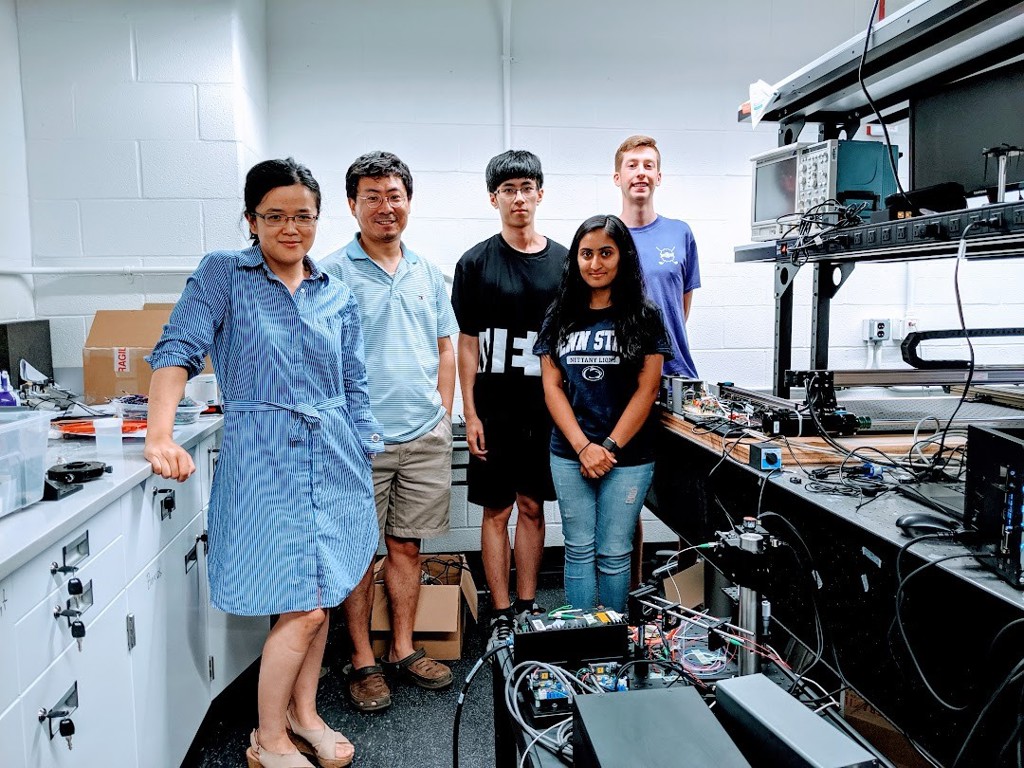About
20 May 2020
Laser-Based Technique Captures 3D Images of Impressionist-Style Brushstrokes
High-definition digital models constructed from OCT images could enhance the study and conservation of artwork
WASHINGTON — Researchers have developed a new strategy that uses optical coherence tomography (OCT) to acquire both the surface and underlying details of impressionist style oil paintings. This information can be used to create detailed 3D reconstructions to enhance the viewing experience and offer a way for the visually impaired to experience paintings.
“Visitors to art museums can’t closely examine paintings and see the artists’ techniques because of security and conservation concerns,” said research team leader Yi Yang from Penn State Abington. “Our new technology can create 3D reconstructions that can be rotated and magnified to view details such as brushstrokes. This would be especially useful for online classes.”

Caption: The researchers acquired OCT imaging data of an impressionist-style oil painting (left image). OCT images within the dotted line were digitally stitched together to produce the 3D images shown in the panels on the right.
Credit: Yi Yang, Penn State Abington
Yang and colleagues from Penn State University Park and New Jersey Institute of Technology report the new technique in the Optical Society (OSA) journal Applied Optics. The research team brought together specialists in art history and conservation with electrical and optical engineers.
The new approach combines OCT with a mechanical scanning stage and new software that allows real-time sampling and removal of image artifacts. Information captured by the technique can be used to 3D print samples so that people with vision impairments can use touch to experience painting techniques such as Van Gogh’s brushstrokes and the pointillism of Seurat’s works.
“The ultra-high definition 3D information can also be used to repair damaged art by allowing a conservator to 3D print the damaged portion and attach it to the original painting,” said Yang. “In addition, the imaging technique can capture high resolution details of artworks that can preserve a digital copy in case of worst-case scenarios such as war, terrorism, natural disaster, heist and other catastrophes.”
Making OCT useful for art analysis
OCT is a laser-based non-invasive imaging technique that can capture images with micrometer resolution. Although it is commonly used for biomedical applications, the imaging technique is useful for art analysis because it can simultaneously capture both topographical information from a painting’s surface and the structure of underlying layers.
“Because today’s OCT systems are optimized for biomedical applications, they have a limited scanning range that severely limits the speed of collecting data from large areas,” said Yang. “We integrated a robotic scanning platform with an advanced OCT system and image processing software to capture the OCT data of paintings beyond the scanning range of typical commercial OCT systems.”

Caption: The Penn State research team delivered the scanning stage to Dr. Xuan Liu’s optics lab at New Jersey Institute of Technology. From left to right, Liu, Yang, Chen, Patel and Eric Carlidge.
Credit: Yi Yang, Penn State Abington
To increase the field of view, individual OCT images captured using the robotic scanner are digitally stitched together to form a larger image. To improve this process, the team developed software that removes distortions and other image artifacts that commonly arise during this type of digital stitching.
The researchers demonstrated their new technique by acquiring OCT images of a portion of an oil painting that mimics the unique impressionist style brushstrokes and measured 10 by 10 centimeters. They also produced a digital 3D model of the scanned area of the painting.
Now that the researchers have proved the new concept, they plan to optimize their system by making improvements in both the hardware and software.
After generating the 3D digital reconstruction of the scanned area, users can interact with the 3D model to gain more insights about the painting, such as brushstrokes. View the Digital 3D Model video based on OCT imaging data, here - https://youtu.be/OUusA1Q0N8k. Video credit: Yi Yang, Penn State Abington
Paper: X. Zhou, D. In, X. Chen, H. M. Bruhn, X. Liu, Y. Yang, “Spectral 3D reconstruction of Impressionist oil paintings based on macroscopic OCT imaging,” Applied Optics, 59, 15, 4733-4738 (2020).
DOI: https://doi.org/10.1364/AO.390326
About The Optical Society
The Optical Society (OSA) is dedicated to promoting the generation, application, archiving, and dissemination of knowledge in optics and photonics worldwide. Founded in 1916, it is the leading organization for scientists, engineers, business professionals, students, and others interested in the science of light. OSA’s renowned publications, meetings, online resources, and in-person activities fuel discoveries, shape real-life applications and accelerate scientific, technical, and educational achievement.
About Optical Materials Express
Optical Materials Express is an open-access journal focusing on the synthesis, processing and characterization of materials for applications in optics and photonics. It is published by Optica Publishing Group and emphasizes advances in novel optical materials, their properties, modeling, synthesis and fabrication techniques; how such materials contribute to novel optical behavior; and how they enable new or improved optical devices. The Editor-in-Chief is Andrea Alù from City University of New York, USA. For more information, visit Optical Materials Express.
Media Contact
